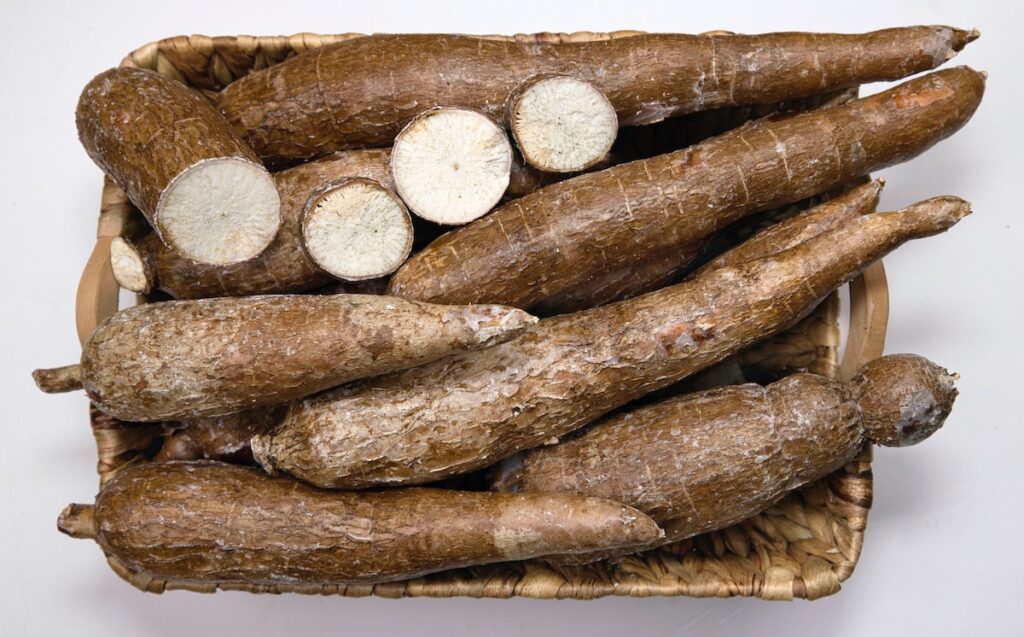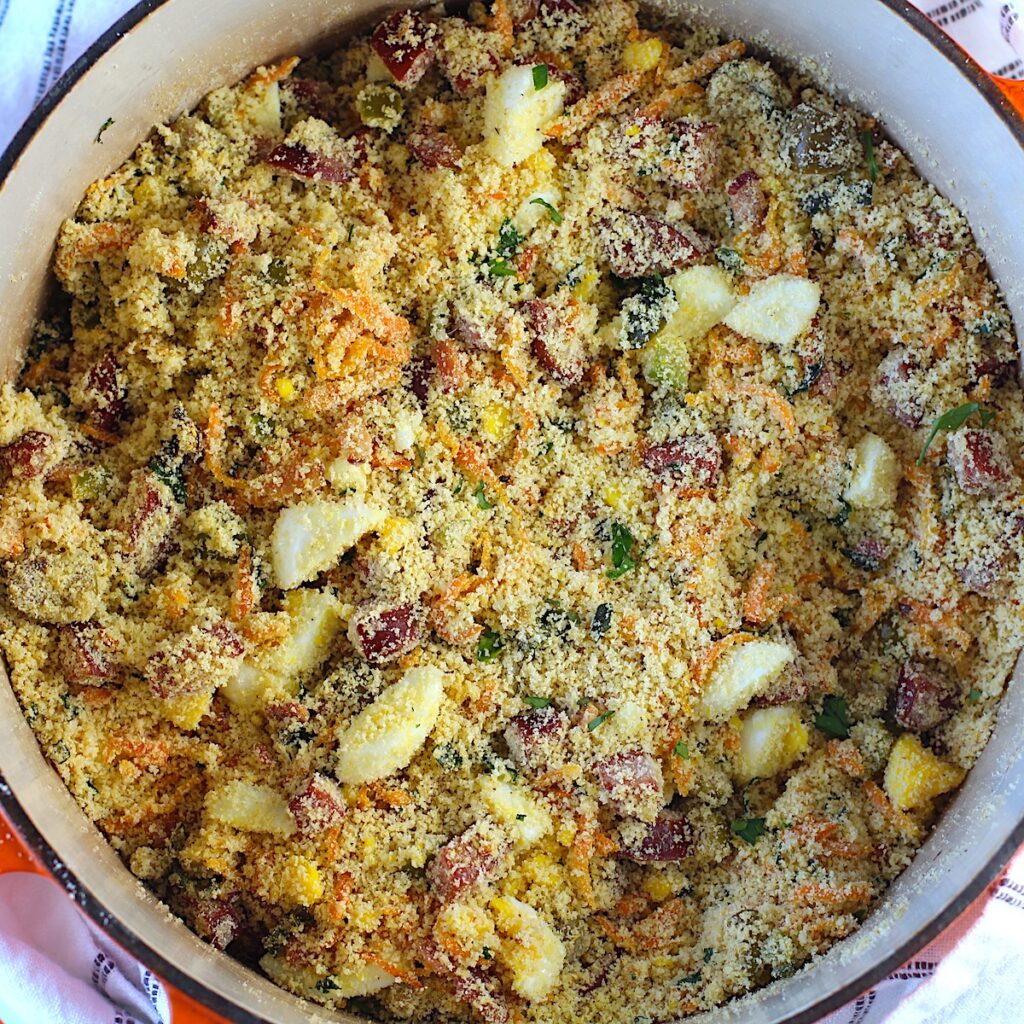Here is everything you ever wanted to know and more about cassava flour vs tapioca starch! Including the root that they come from, how they are made, how to use them, recipes, and more.

Yuca root, otherwise known as cassava, or mandioca in Portuguese, is a very common root vegetable here in Brazil. That's why many of the recipes (now and in the future) on this site contain yuca, cassava flour, or tapioca starch or flour. Since there are a lot of questions about cassava flour vs tapioca starch, I decided to dedicate a post to answering them.
In this article, you will learn the following, so feel free to read it all or jump to the section that you want!
Jump to:
What is Yuca?

Yuca is a starchy root vegetable that is part of the cassava plant that grows primarily in the tropics and is native to South America. This is why yuca is a big part of the cuisine in most countries in Latin America. Brazilians use it in many different ways...fried, mashed, pureed, in stews, in baking, or ground into flour or tapioca starch.
Note, Yuca is not associated with 'yucca' which is an unrelated shrub.
In the United States and much of North America, it's harder to find the actual root vegetable, but you can of course find products made from it, namely flours. While many people may not know this, cassava flour and tapioca, both come from yuca.
What does Yuca taste like?
The flavor when cooked is a very mild or neutral flavor that's a bit starchy, so it's similar to a potato in that sense.
If you do want to cook yuca root, you need to first remove the outer skin, which is very tough, so a knife may be easier than a vegetable peeler. Then you can cook it pretty much just as you would a potato...boil it, roast it, fry it, mash it.
How it's Made: Cassava flour vs Tapioca Starch
Cassava flour is ground cassava root made using the whole root. The entire root (with the tough skin removed) is dried and then ground fine into a flour. The result is that it has both starch (carbohydrates) and fiber. Since it is from a root, it is a grain-free flour and gluten-free alternative.
Cassava starch on the other hand is only the starch from the pulp of the yuca root. The yuca or cassava root is grated and then soaked in water to pull out the starch. The wet pulp is pressed and then the water is then evaporated from the starchy liquid. It leaves only the starch behind, which is a sticky white residue. When dried it can be a fine powder, like a corn starch, or tapioca pearls.
How to use cassava flour
These days, you can usually find cassava flour, or manioc flour, or mandioca flour, at most grocery stores. It's more similar to wheat flour than Tapioca (or cassava) starch because it has some fiber. Therefore, it's a good choice for certain recipes.
For example, in gluten-free baking, you can substitute cassava flour for rice flour or almond flour. It can be a good option for gluten-free recipes, but just be careful when substituting in wheat flour recipes as wheat flour has a higher fiber content and more gluten and will act differently than cassava flour.
You can also use in all purpose flour recipes without yeast. It does not work well in yeast recipes because it lacks gluten to help it rise. Instead, it works in other recipes with leveners such as baking soda or baking powder.
For example, this Cassava Bread is easy to make in a blender and tastes delicious!

You can also use Cassava flour toasted in a delicious Brazilian recipe called Farofa! Check out this Brazilian Farofa Recipe with sausage, carrots, scallions, cilantro, olives, and more! It can be served as a side dish for steak, as a stuffing for chicken or pork, or enjoyed on a big bowl of Feijoada: Rice and Beans Brazilian Style with Meat!

How to use tapioca starch
Tapioca starch, also called Tapioca powder or Tapioca flour, has more limited uses. Here in Brazil, it has two primary uses. It's used in pao de queijo recipes to give the delicious cheese breads their chewy texture. And it's used to make these simple crepes filled with cheese, eggs, ham, tomatoes, or even nutella and fruit.
You can also use tapioca starch as a thickening agent as you would cornstarch. It can help thicken pudding, pie fillings, gravy, soup,or stews.
You can substitute tapioca starch in for cornstarch, potato starch, rice starch. However, you will need to adjust the amounts as it is not necessarily a 1:1 substitute. Depending on the recipe, you may need more tapioca starch vs. potato starch for example. Or you may need 2 tablespoons of tapioca flour starch for each 1 tablespoon of cornstarch.
How to Store Cassava Flour vs. Tapioca starch
Cassava flour and Tapioca Starch should be stored in a cool dry place. Store it in an airtight containers for longest life. It can last up to 6-8 months.
As I live in Brazil, which is generally hot, I like to store cassava flour and tapioca starch in the refrigerator to get the longest life possible for them.
Recipes with Cassava Flour or Yuca
Here are a few yuca and cassava flour recipes:
Cassava flour vs Tapioca Flour: Other FAQs
They are not the same. Tapioca starch and cassava flour come from the cassava plant or yuca root. Arrowroot flour, arrowroot starch, or arrowroot powder come from the Maranta arundinacea plant.
You must always consult your healthcare professional for any dietary questions. While cassava flour is gluten free, every person is different in terms of their dietary needs. If you have a gluten sensitivity, consult with your doctor.





Leave a Reply